If you’ve ever wrapped a workday with mud on your boots, a tape measure in your pocket, and a diesel idling nearby, you’ve probably wondered: what if Caterpillar built a pickup? The idea of a 2026 Caterpillar Pickup has been buzzing around shop floors, farm shows, and forums. Quick reality check up front: Caterpillar has not officially announced a consumer pickup as of today. What follows is a news-style, plain‑English look at what such a truck could be—based on industry logic, real‑world work needs, and the most common rumors (including the often‑misspelled “2026 caterpillar pickup”).
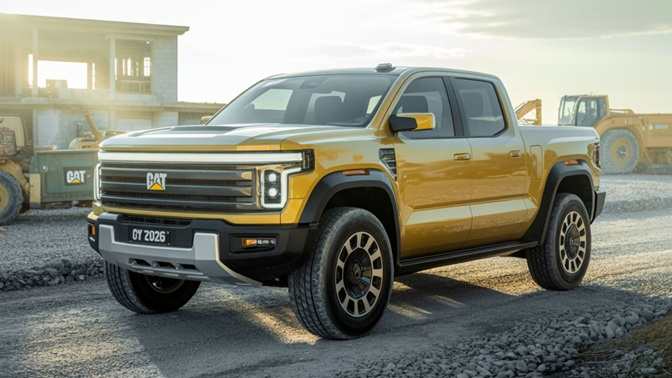
- Status: Unconfirmed. Strong rumor mill; no official product announcement.
- Design vibe: Square‑shouldered, industrial‑clean sheetmetal with serious bed utility.
- Interior: Boots‑friendly materials, big physical controls, and storage that makes sense.
- Powertrains: Gas turbo‑six or V8, a stout diesel for towing, and a hybrid with legit onboard power.
- Modern power: Integrated 120V/240V outlets (think 2–7 kW), perimeter lighting, and app control.
- Features: Smart trailering tools, 360° cameras, upfitter switches, bed rails, legit tie‑downs.
- Price: Competitive with well‑equipped half‑tons—expect mid‑$40Ks to start, premium trims into the $60Ks+.
- Availability: If real, a 2025 reveal with limited 2026 rollout in core work markets would be plausible.
- The big question: Who builds it and who sells it—Caterpillar dealers, auto dealers, or both?
Important Caveat
- No official confirmation: The 2026 Caterpillar Pickup remains a rumor. Treat all specs, features, and pricing here as educated expectations, not promises.
- Why this read still helps: It frames what a work‑first pickup—done Caterpillar’s way—would need to succeed, so you can decide if it’s worth tracking.
Why a Caterpillar pickup actually makes sense
- Brand trust: Caterpillar’s name is practically shorthand for durability in heavy‑duty circles.
- Work DNA: A pickup built by a heavy‑equipment brand could prioritize real utility over gimmicks.
- Power on site: Caterpillar knows generators—onboard power is a natural extension.
- Fleet and telematics: CAT’s experience with machine monitoring could morph into useful light‑duty fleet tools.
- Rural/service networks: If leveraged correctly, service access in the places people actually work is a competitive edge.
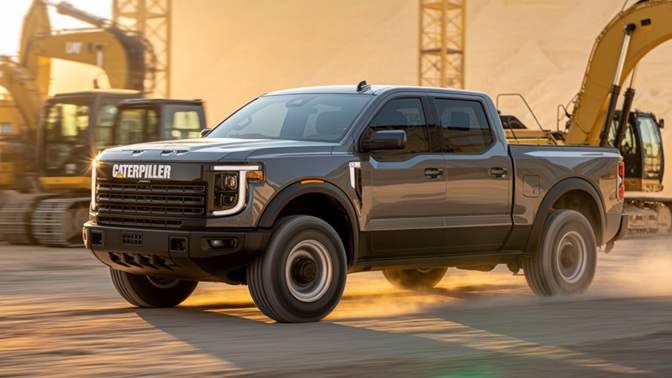
New Design built for work
A flatter hood plane you can see over, and squared fenders that help you place the truck on jobsite ruts. The “Caterpillar look” shouldn’t be toy‑like; it should read as industrial‑clean with high‑function details.
Expected 2026 caterpillar pickup design cues
| Element | What we’d expect |
|---|---|
| Stance | Square and stable, with practical approach/departure angles |
| Lighting | Slim LED DRLs, tough housings, flood‑style bed/mirror lights |
| Bed | Integrated steps, rail system, real tie‑downs, 120V/240V outlets |
| Bumpers | Steel‑friendly with sensor integration and replaceable corners |
| Colors | Work‑ready whites/greys/blacks + a signature deep‑green/yellow accent nod |
interior And Comfort: brains included
A Caterpillar‑style cabin should feel like a good tool chest—everything has its place, and it’s easy to clean after a muddy day.
Interior priorities
- Durable materials: Cloth or vinyl that shrugs off mud; rubberized floor liners; easy‑wipe surfaces.
- Glove‑friendly controls: Big knobs for climate, tow/haul, and 4×4; chunky buttons for work lights and cameras.
- Storage that makes sense: Deep center console, locking compartments, under‑seat bins, door pockets that actually fit bottles and gloves.
- Calm, quiet ride: Extra sealing and insulation to keep the cab relaxed during long highway runs.
- Camera views that help: Bed and hitch cameras, trailer views, and a perimeter 360° system.
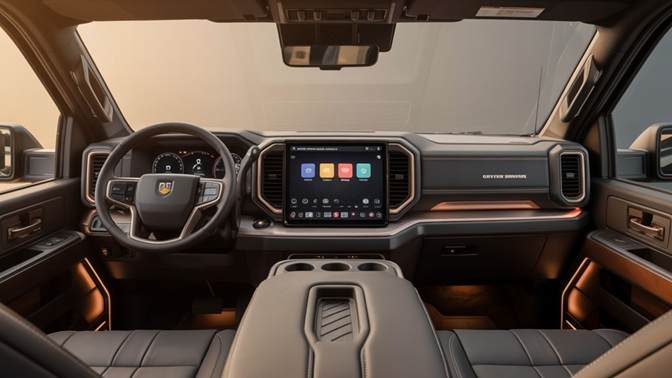
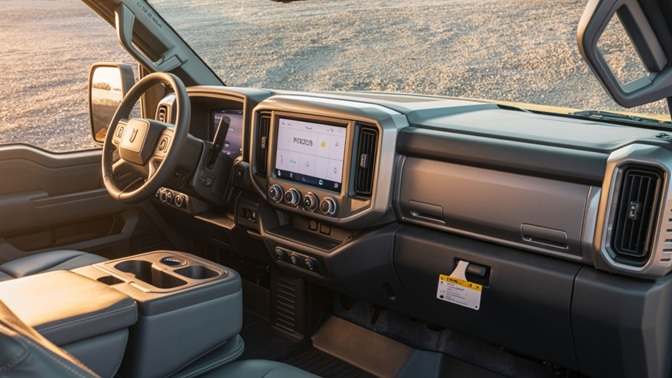
2026 caterpillar pickup interior interior levels (if offered)
| Trim | Seating & materials | Screens |
|---|---|---|
| Work | Durable cloth/vinyl, rubber floors | 8–10″ infotainment + cluster |
| Trail | Sport cloth/SofTex, all‑weather mats | 12″+ infotainment + digital cluster |
| Premium | Leather‑trimmed, heated/ventilated | 12–15″ infotainment + full digital cluster, HUD optional |
Powertrain and “modern power”
The 2026 caterpillar pickup engine list is only half the story. For many, the selling point is the truck’s ability to power tools and small sites without a separate generator.
- Gas turbo‑six or V8: Versatile, familiar, and strong for most job‑and‑family duties.
- Diesel option: A torquey inline‑six or V6 diesel aimed at long‑haul towing and efficiency.
- Hybrid: A high‑output hybrid with a beefy inverter—ideal for welders, compressors, or backup power when the grid blinks.
- Transmissions: 8–10‑speed automatics with tow/haul and off‑road calibrations.
- 4×2 and 4×4: Both available; mechanically lockable rear differential or advanced traction control for off‑road packages.
Modern power (the jobsite electricity piece)
- Outlets: 120V and 240V in‑bed and in‑cab, with weather‑sealed covers and breakers.
- Output: 2.0–7.2 kW class (varies by battery/engine)—enough for most tools, small welders, and backup pumps.
- Controls: In‑dash and app‑based management with power budget readouts and thermal safeguards.
- Quiet running: Engine and cooling tuned to power tools at dawn without waking the whole county.
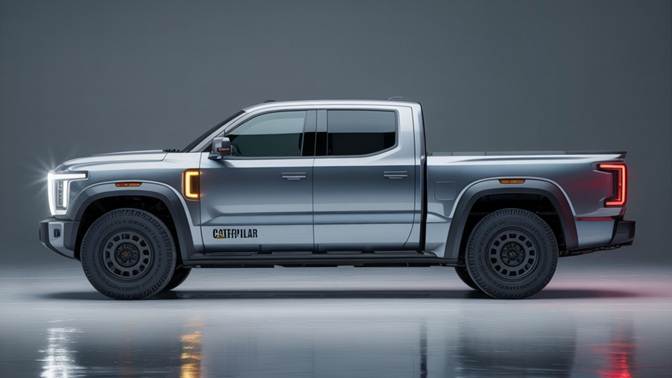
Estimated 2026 caterpiller pickup specs
| Category | Half‑ton target (est.) |
|---|---|
| Max towing | 11,000–13,500 lbs (properly equipped) |
| Max payload | 1,700–2,400 lbs depending on configuration |
| Power (gas) | ~350–420 hp |
| Power (diesel) | ~280–330 hp / 450–600 lb‑ft |
| Hybrid system total | ~375–450 hp, robust low‑rpm torque feel |
| Bed lengths | 5’8” and 6’6” (cab‑dependent) |
| 4×4 hardware | Low‑range, optional rear locker; off‑road shocks/skid plates |
| Onboard power | 2.0–7.2 kW with 120V/240V outlets; app control |
| Cameras | 360°, bed, hitch, and trailer views |
| Safety | AEB, lane‑keep, blind‑spot with trailer, adaptive cruise (availability by trim) |
Features that actually matter on the job
- Bed ecosystem: Integrated rails, sliding cleats, stake pockets with rated loads, and a tailgate you can use as a workstation (measuring marks, clamp points).
- Smart trailering: Trailer profiles, light check wizard, jack‑knife alert, “transparent trailer” view on compatible rigs.
- Lighting: Bed and perimeter LEDs with dedicated physical buttons; timed shutoff and app scheduling.
- Upfitter‑friendly wiring: Factory auxiliary switch bank with labeled, fused circuits—no rat’s nest required.
- Cold‑weather kit: Heated seats, wheel, mirrors, and wiper de‑icers; remote start that respects battery and power demands.
- Telematics lite: Maintenance reminders, route logging, idle time tracking, and error‑code translation for small fleets.
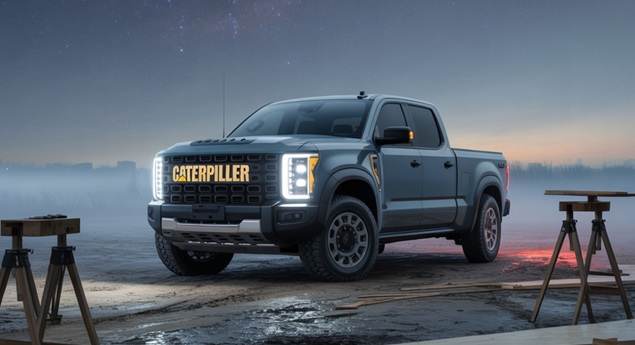
2026 Caterpillar pickup price
If Caterpillar plays in the heart of the market, expect pricing to mirror strong half‑ton competitors—value‑driven work trims and well‑equipped premium models.
| Trim (est.) | Drivetrain | Target buyer | Est. starting price |
|---|---|---|---|
| Work | 4×2 or 4×4 | Fleet, farm, trades—value first | $44,000–$49,000 |
| Trail | 4×4 | Ranch/off‑road users, weekend and work | $54,000–$60,000 |
| Premium | 4×4 | Owner‑operators and long‑haulers | $62,000–$72,000 |
| Diesel option | 4×2/4×4 | Tow‑first buyers | +$6,000–$10,000 over gas |
| Hybrid with high‑output power | 4×4 | Jobsite power users | +$3,500–$6,000 over base gas |
Notes
- Focus on out‑the‑door pricing (taxes, destination, doc fees). Add‑ons stack fast.
- Expect package bundling—Tow/Max Trailering, Off‑Road/Protection, Tech/Safety, Cold Weather, and Bed Utility.
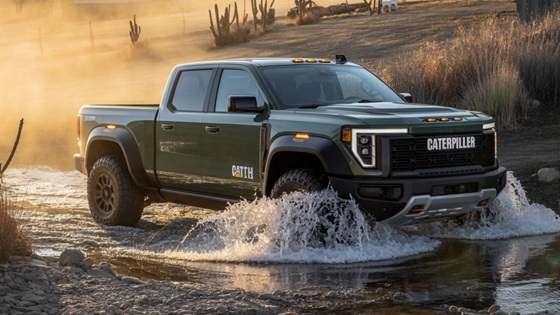
Rumors roll call: what feels likely, what feels wishful
| Rumor | What it implies | Confidence |
|---|---|---|
| Partner‑built platform | Caterpillar collaborates with an established automaker/contract builder | High (starting from scratch is costly) |
| Diesel + hybrid lineup | Two‑pronged approach: towing torque and jobsite electricity | Medium‑high |
| Deere‑like dealer crossover | Sales/service via select Caterpillar dealers in rural markets | Medium (regulatory hurdles) |
| CAT‑style telematics | Light‑duty fleet tools inspired by CAT’s heavy equipment systems | Medium |
| Limited first‑year run | Controlled launch to manage quality and supply | Medium‑high |
| Fast‑follow HD variant | Three‑quarter‑ton class or chassis‑cab | Low‑medium (depends on the half‑ton’s success) |
Release Date and timeline & where you’d buy it
A plausible rollout—if the program exists and is on track:
- Reveal: Late 2025 at a major farm show or an industry expo
- Orders: Early–mid 2026 for core configurations
- First deliveries: Mid‑to‑late 2026 in priority states/regions
- 2026 caterpillar pickup for sale: 2027 model‑year expansion with more trims and powertrains
Where would it be sold and serviced?
- Dealer model: This is the million‑dollar question. Light‑duty 2026 caterpillar pickup come with regulatory, warranty, and retail requirements different from heavy equipment.
- Likely solution: A co‑branded approach—traditional auto dealer infrastructure for consumer‑grade sales, with Caterpillar’s network supporting commercial buyers and fleets (purely speculative, but logical).
- Service strengths: If Caterpillar’s parts logistics and uptime culture carry over, that’s a real differentiator in rural markets.
Competitive landscape (who it must beat at their own game)
- Ford F‑150: Swiss‑army lineup, proven Pro Power Onboard for jobsite electricity.
- Chevy Silverado/GMC Sierra: Strong towing and much‑improved interiors; deep dealer networks.
- Ram 1500: Ride comfort and cabin quality that set the bar in many trims.
- Toyota Tundra: Twin‑turbo V6 + hybrid punch; growing trailer tech.
- Rivian R1T / F‑150 Lightning: EV smoothness and silent power export—range and charging are the tradeoffs in rural zones.
If you’re sizing this up against the field, the Caterpillar pitch would be: utility first, power on demand, and durability that feels “industrial grade” without beating you up on the daily commute.
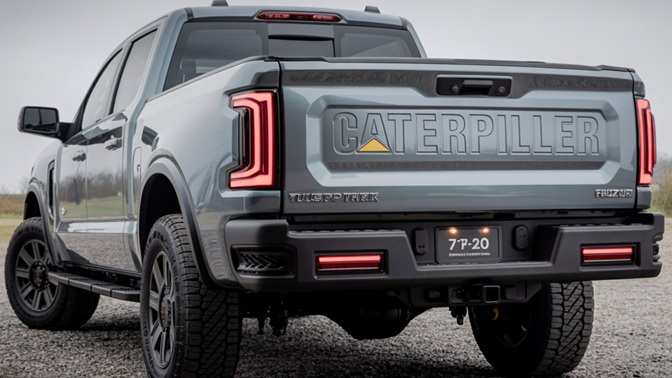
Shopping checklist (if it launches)
- Nail your use‑case: Towing weight, trailer type, daily load, jobsite power needs, and terrain.
- Choose your drivetrain: Fewer moving parts? Gas. Long‑haul towing? Diesel. Power tools and backup electricity? Hybrid.
- Lock the bed stuff: Rail system, tie‑downs, tailgate needs, bedliner, in‑bed outlets.
- Don’t skimp on cameras: Hitch and surround views pay for themselves in saved fenders and faster hookups.
- Think winter: Heated everything and remote start if you plow, feed, or roll out pre‑dawn.
- Price the whole build: Truck, packages, accessories, and any upfit work (racks, boxes, lighting).
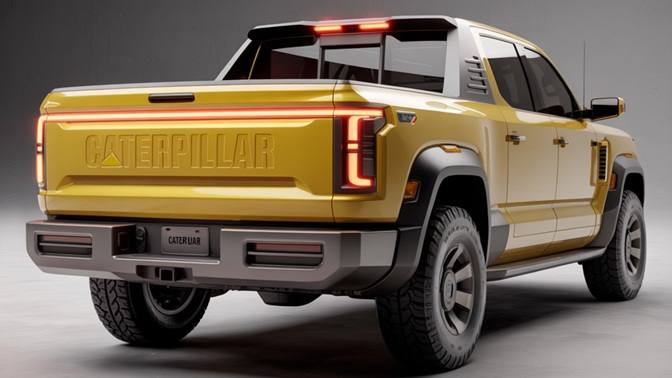
FAQs/Frequently Asked Questions
Is the 2026 Caterpillar Pickup real?
Not officially announced. It’s a well‑traveled rumor with a logical business case, but nothing confirmed by Caterpillar.
What would the 2026 caterpillar pickup design look like?
Expect a square‑shouldered, industrial‑clean body with a practical bed—integrated steps, rail system, real tie‑downs—and durable steel‑friendly bumpers.
What’s the likely 2026 caterpillar pickup price?
We’d expect the Work trim around the high‑$40Ks, Trail around the mid‑$50Ks, and Premium in the low‑$60Ks to low‑$70Ks before options. Diesel and high‑output hybrid systems would add several thousand dollars.
What’s the interior like?
Boots‑friendly materials, big physical knobs, and clever storage. Higher trims would bring leather‑trim, larger screens, ambient lighting, and advanced driver assists.
What about the powertrain and modern power?
Gas turbo‑six or V8 for the broad middle, torquey diesel for heavy towing, and a hybrid with 120/240V outlets for serious onboard power—2 to 7 kW depending on configuration.
What features stand out?
Smart trailering (profiles, light check, transparent trailer), perimeter lighting, upfitter switches, cold‑weather kit, and a robust camera suite that actually makes your day easier.
When would it be 2026 caterpillar pickup available?
If real, a late‑2025 reveal and a limited 2026 launch in priority markets would make sense. Broader rollout could follow in 2027.
Where could you buy it?
Dealer strategy is unclear. A blended approach leveraging auto dealer networks and CAT’s commercial footprint seems the most plausible path (again—speculation).
head vs. heart
- Head: Launching a pickup is expensive and regulation‑heavy. A partner platform and shared factories are almost mandatory.
- Heart: A Caterpillar‑branded truck that’s unapologetically work‑first—with industrial durability, onboard power, and an interior that cleans up easy—sounds exactly like what many rural and trade buyers have been asking for.
A 2026 Caterpillar Pickup—spelled “caterpiller” in plenty of search bars—doesn’t need to reinvent the wheel. It needs to refine it for real life: square‑shouldered design, a bed that’s a true tool, a cabin you don’t have to baby, powertrains that tow without drama, and a hybrid that doubles as your jobsite generator. If Caterpillar pulls the trigger with the right partner, expect demand to be fierce out of the gate—especially in farm, ranch, oilfield, and construction country. Until then, keep one eye on official filings and trade‑show calendars, and have your spec sheet ready. If the green light comes, the early trucks will go fast—and the folks who know exactly what they want will get the first call.
Related Post




